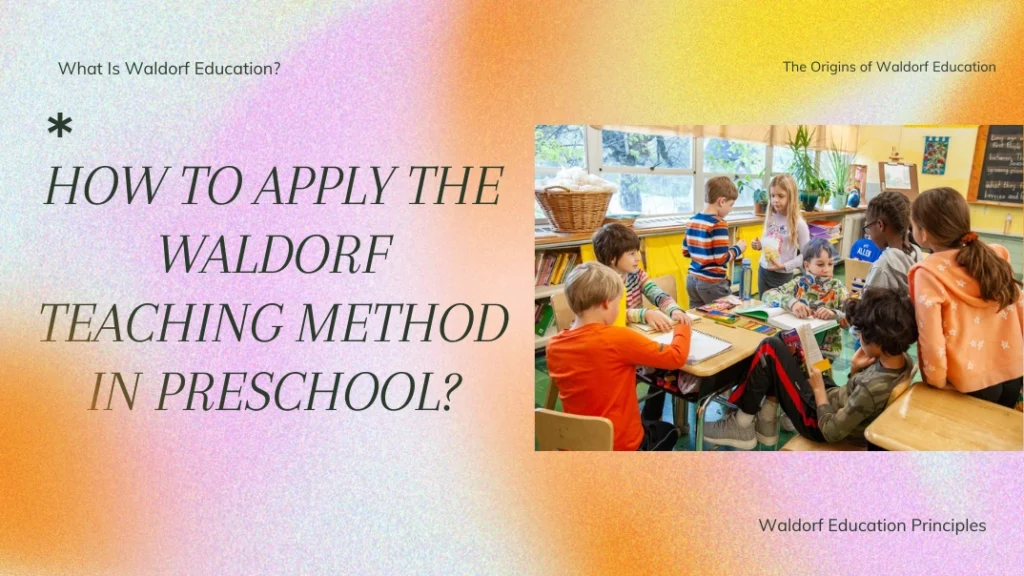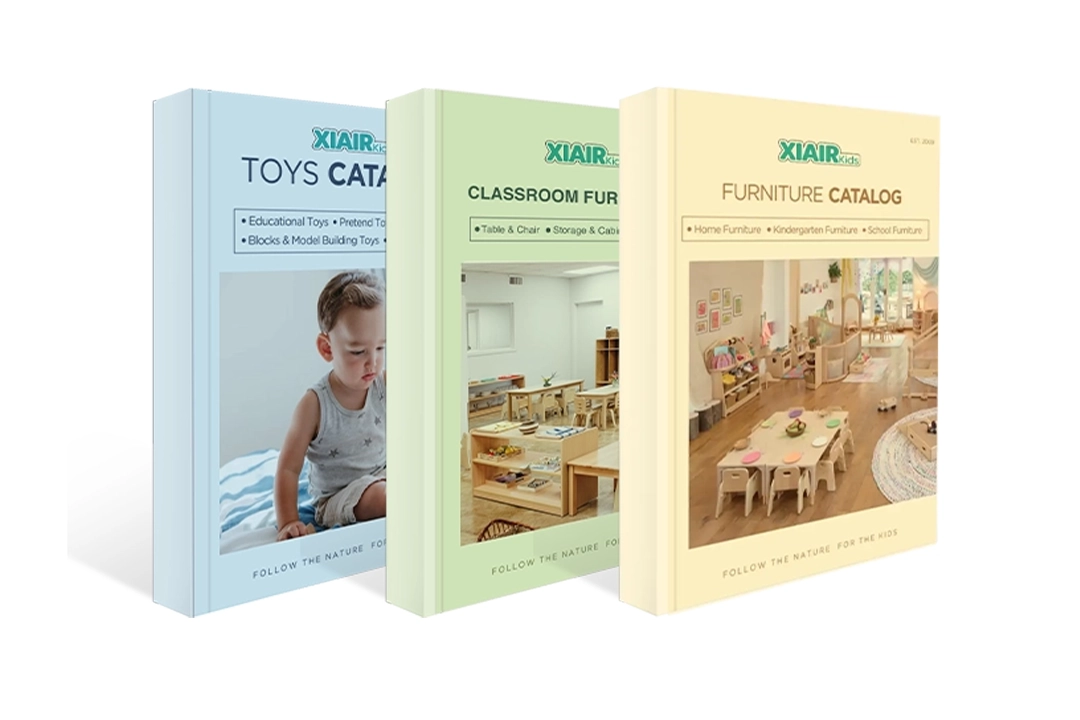Metoda nauczania Waldorf zyskała znaczną popularność na całym świecie, zwłaszcza w przedszkolach, gdzie priorytetem jest holistyczny rozwój dziecka. Ale czym dokładnie jest Edukacja waldorfskai jak można skutecznie wdrożyć program nauczania Waldorf w przedszkolach? Ta metoda wyróżnia się ze względu na wyjątkowe skupienie na rozwoju całego dziecka — umysłu, ciała i ducha — oraz nacisk na kreatywność, niezależność i więź z naturą. Ten artykuł przeprowadzi Cię przez zasady edukacji Waldorf, jej zalety i wady oraz jak włączyć jej metodologie do swojej klasy.
Metoda nauczania Waldorf, wywodząca się z filozofii edukacyjnej Rudolfa Steinera, stawia na pierwszym miejscu naukę przez doświadczenie, wspieranie kreatywności i głęboką relację z naturą. Włączając edukację Waldorf do przedszkola, dzieci otrzymują przygotowanie akademickie i są wychowywane, aby stać się kreatywnymi myślicielami, odpowiedzialnymi osobami i uczącymi się przez całe życie.
Metoda nauczania Waldorf różni się od tradycyjnej edukacji, zapewniając bardziej zrównoważone, holistyczne podejście do nauki dzieciństwa. Dzięki pedagogice Waldorf dzieci doświadczają bogatego środowiska edukacyjnego obejmującego przedmioty akademickie, sztukę, umiejętności praktyczne i rozwój osobisty. Jednak edukatorzy i rodzice muszą zrozumieć, że wdrożenie metody nauczania Waldorf wymaga zaangażowania w jej podstawowe zasady.
Czym jednak metoda nauczania waldorfskiego różni się od modeli tradycyjnych i jak można ją zintegrować z placówkami edukacji wczesnoszkolnej? Zacznijmy od przyjrzenia się, czym tak naprawdę jest pedagogika waldorfska.
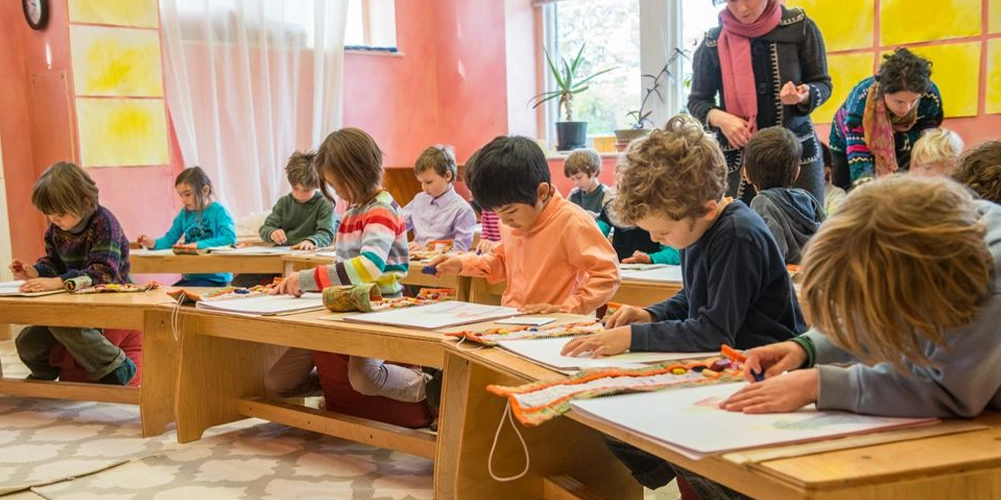
Wstęp
Metoda nauczania Waldorf znana jest z kreatywnego, skoncentrowanego na dziecku podejścia do nauki. Zakorzeniona w ideach Rudolfa Steinera, pedagogika waldorfska jest praktykowana w szkołach i przedszkolach na całym świecie. W przeciwieństwie do tradycyjnych sal lekcyjnych, szkoły waldorfskie cenią praktyczne doświadczenia, silne poczucie rytmu i bliski kontakt z naturą. Ten wyjątkowy sposób nauczania zainspirował wielu rodziców i nauczycieli do poszukiwania nowych sposobów wspierania naturalnego rozwoju każdego dziecka i jego zamiłowania do nauki. W kolejnych rozdziałach omówimy główne idee i zasady, które sprawiają, że metoda waldorfska jest tak wyjątkowa.
Metoda nauczania Waldorf: podstawy i podstawowe zasady
Metoda nauczania Waldorf zakłada, że dzieci uczą się najlepiej, gdy ich umysł, ciało i emocje są ze sobą połączone. Zapoczątkowana przez Rudolfa Steinera, metoda ta postrzega każde dziecko jako wyjątkowe, przechodzące przez różne etapy rozwoju. W klasach waldorfskich nauka jest praktyczna i kreatywna, z dużą ilością czasu na zabawę, sztukę i odkrywanie natury. Stały rytm dnia i pór roku pomaga dzieciom czuć się bezpiecznie. Nauczyciele szanują tempo każdego dziecka i dostosowują lekcje do potrzeb klasy. Te proste, ale skuteczne idee wyróżniają metodę nauczania Waldorf na tle tradycyjnej edukacji.
Kim jest Rudolf Steiner?
Rudolf Steiner był austriackim filozofem, reformatorem społecznym i pedagogiem, znanym przede wszystkim z założenia ruchu pedagogicznego waldorfskiego. Steiner uważał, że edukacja powinna rozwijać wszystkie aspekty umysłu, ciała i ducha dziecka. Jego idee ukształtowały to, co obecnie nazywamy metodą nauczania waldorfskiego, czyli edukacją Steinera, która jest praktykowana w wielu szkołach waldorfskich na całym świecie. Filozofia Steinera, znana jako antropozofia, leży u podstaw wszystkich zasad pedagogiki waldorfskiej.
Dziś pedagogika Steinera i waldorfska są ze sobą ściśle powiązane. Wielu nauczycieli, rodziców i szkół waldorfskich wciąż studiuje wykłady i pisma Steinera, aby lepiej zrozumieć unikalną specyfikę tego podejścia. System waldorfski promuje kreatywność, indywidualność i silne poczucie więzi ze światem – wizję, którą po raz pierwszy przedstawił Rudolf Steiner ponad sto lat temu.
Dzięki wpływowi Steinera szkoły waldorfskie rozprzestrzeniły się na całym świecie, między innymi w Stanach Zjednoczonych, Europie i Azji. Wizja edukacji Rudolfa Steinera, obecnie nazywana podejściem Steinera Waldorfa, charakteryzuje się łączeniem przedmiotów akademickich ze sztuką, zajęciami praktycznymi i szacunkiem dla rozwoju dziecka.
Czym jest pedagogika waldorfska?
Pedagogika waldorfska, czasami nazywana metodą nauczania waldorfskiego lub edukacją Steinera, to metoda nauczania, która koncentruje się na całościowym rozwoju dziecka. Metoda ta jest stosowana w szkołach waldorfskich, przedszkolach waldorfskich, a nawet w publicznych programach edukacji waldorfskiej. W swojej istocie edukacja waldorfska zachęca dzieci do nauki poprzez działanie, z dużą ilością zabawy, sztuki, muzyki i zajęć praktycznych.
Sale lekcyjne waldorfskie różnią się wyglądem i charakterem od tradycyjnych szkół. Często znajdują się w nich drewniane zabawki, naturalne materiały i kreatywne przestrzenie, w których dzieci mogą odkrywać świat. Program nauczania uwzględnia naturalne etapy dzieciństwa i ceni tempo rozwoju każdego dziecka. To wyjątkowe środowisko edukacyjne jest jedną z cech charakterystycznych pedagogiki waldorfskiej i tym, co wyróżnia metodę waldorfską na tle innych systemów edukacyjnych.
Rodziny chętnie wybierają podejście waldorfskie, ponieważ kładzie ono nacisk na wyobraźnię, umiejętności praktyczne i zamiłowanie do nauki, które trwa całe życie. Filozofia edukacji waldorfskiej szanuje znaczenie rutyny, rytmu i silnej więzi między domem a szkołą. Obecnie na całym świecie istnieją tysiące szkół waldorfskich i steinerowskich, z których każda poświęca się pomaganiu dzieciom w rozwoju w myślących, pewnych siebie i współczujących dorosłych.
Nie tylko o tym marz, zaprojektuj to! Porozmawiajmy o Twoich potrzebach w zakresie mebli na zamówienie!
Początki edukacji waldorfskiej
Pierwsza szkoła waldorfska została założona w 1919 r. dla dzieci pracowników fabryki papierosów Waldorf-Astoria w Stuttgarcie w Niemczech. Rudolf Steiner wyobraził sobie system edukacji, który rozwijał zdolności intelektualne uczniów oraz ich zdolności artystyczne, praktyczne i moralne. System edukacji waldorfskiej został zaprojektowany tak, aby był dynamiczny i elastyczny, dając nauczycielom swobodę tworzenia lekcji dostosowanych do konkretnych etapów rozwoju ich uczniów. Celem było wykształcenie wszechstronnie rozwiniętych jednostek zdolnych do znaczącego wkładu w społeczeństwo.
Edukacja Steinera i Waldorfa rozszerzyła się na cały świat, a obecnie na całym świecie działają tysiące szkół Waldorf. Każda szkoła Waldorf wdraża metodę nauczania Waldorf, dostosowując zasady Steinera do kontekstów kulturowych, geograficznych i społecznych swoich uczniów. Niezależnie od tego, czy jest to szkoła wiejska, czy miejska, program nauczania Waldorfa koncentruje się na rozwoju całego dziecka poprzez zajęcia akademickie i pozaakademickie.
Obecnie szkoły waldorfskie obejmują wiele kontynentów, oferując edukację od przedszkola do szkoły średniej. Szkoły te nadal podążają za zasadami Rudolfa Steinera, koncentrując się na holistycznym rozwoju każdego dziecka.

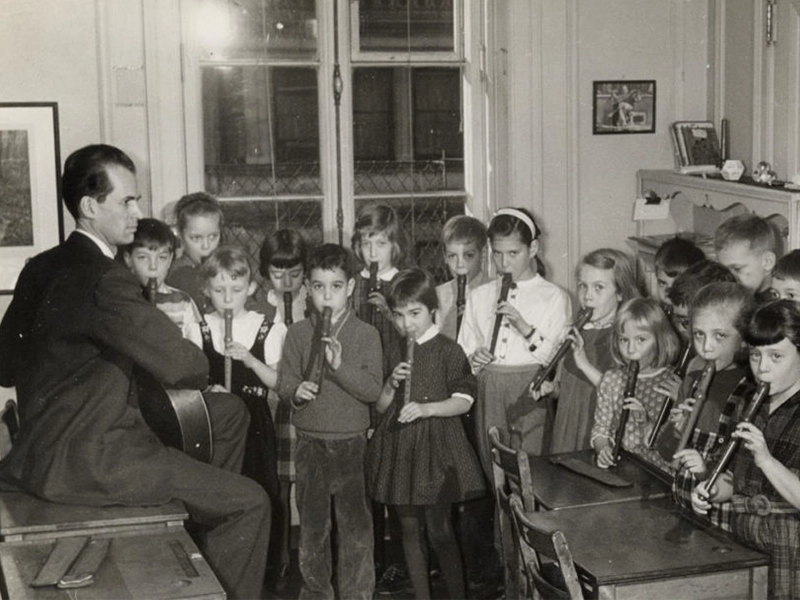
Podstawy edukacji waldorfskiej
Edukacja waldorfska opiera się na przekonaniu, że dzieci przechodzą przez trzy odrębne fazy rozwojowe: wczesne dzieciństwo, środkowe dzieciństwo i okres dojrzewania. Każdy z tych etapów charakteryzuje się określonymi potrzebami rozwojowymi, które są adresowane w programie nauczania waldorfskiego w sposób, który wspiera naturalny wzrost dziecka i jego zdolność uczenia się.
Wczesne dzieciństwo
Wczesne dzieciństwo, edukacja waldorfska koncentruje się na uczeniu się poprzez zabawę, naśladownictwo i doświadczenia sensoryczne. Środowisko klasy waldorfskiej jest celowo proste i wypełnione naturalnymi materiałami, takimi jak drewniane zabawki i wełna, które sprzyjają połączeniu z naturą. Ta faza edukacji waldorfskiej pozwala dzieciom rozwijać swoje ciała fizyczne i zmysły poprzez znaczące zadania, takie jak gotowanie, sprzątanie i ogrodnictwo.
Do najważniejszych aspektów programu nauczania przedszkolnego waldorfskiego należą:
- Kreatywna zabawa:Na tym etapie podstawą pedagogiki waldorfskiej jest nauka oparta na zabawie. Dzieci są zachęcane do angażowania się w kreatywną zabawę prostymi, naturalnymi zabawkami, które pobudzają kreatywność.
- Opowiadanie historii i rytm:Opowiadanie historii ustnie, piosenki i wiersze stanowią istotną część codziennych czynności, zapewniając rytmiczną strukturę, która daje dzieciom poczucie bezpieczeństwa.
- Praktyczne umiejętności życiowe:Dzieci biorą udział w takich zadaniach jak pieczenie chleba, sprzątanie klasy i sadzenie roślin w ogrodzie, co pomaga rozwijać umiejętności motoryczne i sprzyja niezależności.
Metoda nauczania Waldorf kładzie nacisk na pielęgnowanie fizycznych, emocjonalnych i wyobrażeniowych zdolności dzieci na tym etapie. Poprzez praktyczne zadania i zabawę dzieci doświadczają świata i rozwijają podstawowe umiejętności, które wspierają przyszłą naukę akademicką. Klasa Waldorf na tym poziomie jest celowo pozbawiona gadżetów high-tech lub ekranów, co jest zgodne z filozofią Waldorf, że dzieci powinny bardziej bezpośrednio angażować się w swoje otoczenie.
W przedszkolu waldorfskim nauczyciel odgrywa kluczową rolę w kształtowaniu zachowań, które dzieci mogą naśladować. Podkreśla to kolejną fundamentalną zasadę metody nauczania waldorfskiego: dzieci uczą się najlepiej poprzez przykład, a nie poprzez bezpośrednie instrukcje na tak wczesnym etapie. Sale lekcyjne waldorfskie są często opisywane jako spokojne i sprzyjające rozwojowi przestrzenie, zachęcające do kreatywnej zabawy i eksploracji.
Średnie dzieciństwo
W szkołach waldorfskich intelektualne uczenie się zaczyna kształtować się w średnim dzieciństwie. Jednak zgodnie z filozofią Steinera, metoda edukacji waldorfskiej nadal kładzie nacisk na doświadczalne uczenie się i ekspresję artystyczną jako główne środki rozwoju intelektualnego.
Kluczowe elementy programu nauczania waldorfskiego na tym etapie obejmują:
- Główne bloki lekcji:Przedmioty akademickie, takie jak matematyka, literatura i nauki ścisłe, są nauczane w intensywnych blokach trwających kilka tygodni, co pozwala uczniom w pełni zagłębić się w temat.
- Integracja artystyczna:Każdy przedmiot w klasie waldorfskiej jest nauczany za pomocą metod artystycznych — rysunek, malarstwo, opowiadanie historii i teatr są wykorzystywane w celu uczynienia złożonych idei bardziej namacalnymi i zrozumiałymi.
- Zajęcia praktyczne:Zgodnie z filozofią waldorfską dzieci angażują się także w zadania praktyczne, takie jak prace ręczne i obróbka drewna, które integrują umiejętności poznawcze i fizyczne.
W tej fazie filozofia szkoły waldorfskiej kładzie nacisk na rozwój inteligencji emocjonalnej, kładąc nacisk na kreatywność, wyobraźnię i współpracę.
Metoda nauczania Waldorf w okresie średniego dzieciństwa pomaga dzieciom rozwijać się emocjonalnie i intelektualnie, przygotowując je do bardziej rygorystycznych wymagań akademickich okresu dojrzewania. Wiadomo, że nauczyciele w szkołach Waldorf pozostają z tą samą grupą uczniów przez kilka lat, pielęgnując silne, oparte na zaufaniu relacje, które przyczyniają się do stabilnego środowiska edukacyjnego. Ta ciągłość jest kluczową cechą systemu edukacji Waldorf, odróżniającą go od tradycyjnych szkół, w których uczniowie często zmieniają nauczycieli.
Edukacja waldorfska kładzie nacisk również na zabawę na świeżym powietrzu i kontakt z naturą w okresie średniego dzieciństwa. Codzienne zajęcia na świeżym powietrzu, spacery po przyrodzie i wycieczki terenowe są zintegrowane z programem nauczania waldorfskiego, aby pomóc dzieciom nawiązać kontakt ze środowiskiem, co dodatkowo odzwierciedla podstawowe wartości szkół waldorfskich.
Adolescencja
Gdy dzieci wkraczają w okres dojrzewania, program nauczania Waldorfa przechodzi w kierunku rozwijania krytycznego myślenia, refleksji etycznej i odpowiedzialności społecznej. Szkoły Waldorf na tym etapie kładą nacisk na samodzielną naukę, zaangażowanie społeczne i realizację osobistych zainteresowań.
Kluczowe aspekty tej fazy obejmują:
- Myślenie krytyczne:Zachęcamy młodzież do angażowania się w debaty filozoficzne, projekty badawcze i zadania analityczne w celu rozwijania umiejętności rozumowania i refleksji.
- Nauka poprzez służbę:Zgodnie z zasadami szkoły waldorfskiej uczniowie biorą udział w projektach społecznych, kładąc nacisk na odpowiedzialność społeczną i świadomość etyczną.
Na tym etapie metoda nauczania Waldorf pomaga nastolatkom zrozumieć swoją rolę w społeczności i na całym świecie. Nauczyciele waldorfscy stają się mentorami, wspierając uczniów w rozwijaniu niezależności i silnego poczucia celu.
W Szkoły waldorfskie, okres dojrzewania to czas odkrywania siebie i rozwoju osobistego. Program nauczania jest tak zaprojektowany, aby stawiać uczniom wyzwania intelektualne i emocjonalne, pomagając im stać się empatycznymi, rozważnymi osobami gotowymi do pozytywnego wkładu w społeczeństwo. Szkoły waldorfskie na całym świecie nadal wdrażają te zasady, aby zapewnić uczniom ukończenie szkoły z wszechstronnym wykształceniem wykraczającym poza osiągnięcia akademickie.
Twoja idealna klasa jest tylko jedno kliknięcie stąd!
Zasady edukacji waldorfskiej
Kilka podstawowych zasad definiuje filozofię edukacji waldorfskiej. Zasady te kierują sposobem, w jaki nauczyciele wchodzą w interakcje ze studentami i kształtują program nauczania, aby wspierać holistyczne doświadczenie edukacyjne.
Człowiek jako istota duchowa
Jednym z głównych przekonań pedagogiki waldorfskiej jest to, że dzieci są istotami duchowymi o wyjątkowych przeznaczeniach. Metoda nauczania waldorfskiego zachęca do rozwoju duchowego dziecka, nie w sensie religijnym, ale poprzez pielęgnowanie poczucia zachwytu i szacunku dla życia. Klasy waldorfskie są zaprojektowane tak, aby wzbudzać podziw poprzez piękno naturalnych materiałów, rytmy sezonowe i ekspresję artystyczną.
Metoda nauczania Waldorf jest ściśle powiązana z rytmami świata przyrody, a rytmy dzienne, tygodniowe i sezonowe pomagają stworzyć przewidywalne, bezpieczne środowisko dla małych dzieci. Na przykład w przedszkolu Waldorf piosenki, wiersze i zajęcia sezonowe pomagają dzieciom nawiązać kontakt z naturalnym biegiem czasu. Duchowy aspekt edukacji Waldorf kładzie nacisk na rozwój unikalnego potencjału i poczucia własnej wartości każdego dziecka, pomagając im stać się empatycznymi, społecznie odpowiedzialnymi jednostkami.
Wolność w nauczaniu
W systemie Waldorf nauczyciele mają znaczną swobodę w prowadzeniu lekcji. Metoda edukacji Waldorf pozwala edukatorom dostosować program nauczania do potrzeb i zainteresowań uczniów, zapewniając, że nauka pozostaje angażująca i istotna. Ta swoboda twórcza odróżnia szkoły Waldorf od tradycyjnych systemów edukacyjnych, w których sztywne programy nauczania mogą ograniczać indywidualne doświadczenia edukacyjne.
Nauczyciele waldorfscy mają autonomię w tworzeniu lekcji, które pobudzają ciekawość i kreatywność. Wykorzystują swoje obserwacje rozwoju dzieci, aby kierować treścią i metodami nauczania. Ta swoboda pozwala nauczycielom w szkołach waldorfskich personalizować doświadczenie edukacyjne dla każdego dziecka, sprawiając, że edukacja jest organicznym i ewoluującym procesem, a nie procesem standaryzowanym.
Metoda nauczania Waldorf ceni rolę nauczyciela jako wychowawcy i kreatywnego przewodnika. Dzięki temu możliwe jest tworzenie dynamicznych i elastycznych środowisk edukacyjnych, które zachęcają uczniów do odkrywania swoich zainteresowań i talentów.
Nauka przez doświadczenie i budowanie relacji
Edukacja waldorfska stawia na pierwszym miejscu naukę przez doświadczenie, w której dzieci angażują się w przedmioty poprzez działania praktyczne. Niezależnie od tego, czy chodzi o malowanie, ogrodnictwo czy opowiadanie historii, uczniowie w klasie waldorfskiej uczą się przez działanie. Ponadto bliska relacja między nauczycielem a uczniem jest kolejną cechą charakterystyczną pedagogiki waldorfskiej. Nauczyciele często pozostają z tą samą grupą uczniów przez kilka lat, pielęgnując głębokie więzi, które wzbogacają doświadczenie edukacyjne.
Metoda nauczania Waldorf przywiązuje dużą wagę do relacji, które tworzą się w klasie. Prowadzenie uczniów przez tego samego nauczyciela przez kilka lat buduje silną więź zaufania i zrozumienia, tworząc wspierające środowisko, w którym uczniowie czują się bezpiecznie, aby wyrażać siebie i podejmować ryzyko w swojej nauce. Ta ciągłość jest niezbędna w systemie edukacji Waldorf, promując stabilność i bezpieczeństwo emocjonalne w trakcie całej szkolnej podróży dziecka.
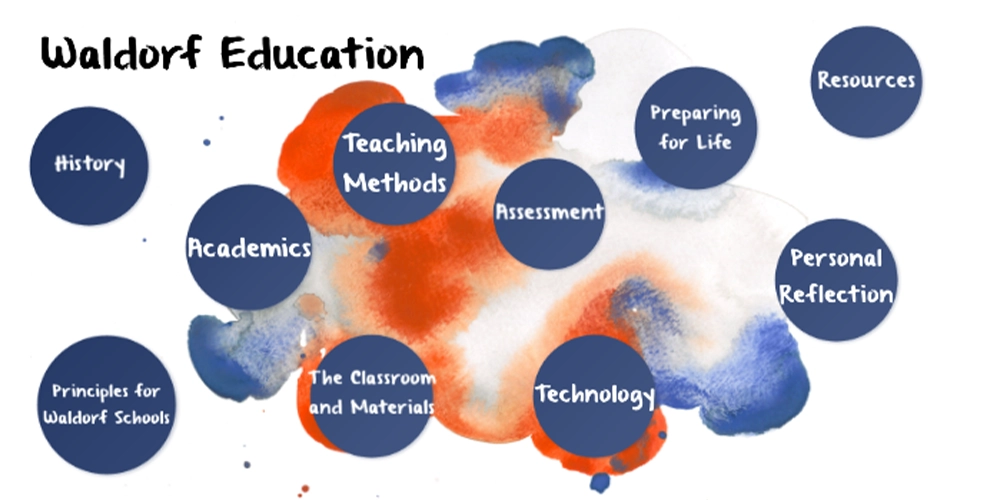
Zalety i wady metody nauczania Waldorf
Rozważając system edukacji Waldorf dla środowisk przedszkolnych, ocena jego mocnych stron i potencjalnych wyzwań jest niezbędna. Poniżej znajduje się kompleksowy przegląd zalet i wad podejścia Waldorf.
Zalety:
- Nauka odbywa się w sposób praktyczny i dostosowany do wieku
Metoda nauczania Waldorf kładzie nacisk na naukę przez doświadczenie i dotyk, pozwalając dzieciom angażować się w aktywności dostosowane do ich etapu rozwoju. - Nauka odbywa się poprzez zabawę
Zabawa stanowi istotny element edukacji w przedszkolach waldorfskich, wspomagając kreatywność, rozwój poznawczy i umiejętności społeczne. - W klasie nie wykorzystuje się technologii.
Model edukacyjny Waldorfa celowo minimalizuje wykorzystanie technologii, zachęcając dzieci do bezpośredniego angażowania się w otaczający je świat. - Uczniowie uczą się, jak brać aktywny udział w swojej edukacji
Metoda waldorfska zachęca dzieci do samodzielnej nauki, wspiera niezależność i ciekawość. - Szkoły waldorfskie kształcą wszechstronnie rozwiniętych ludzi.
Holistyczne podejście pedagogiki waldorfskiej wspiera rozwój zdolności intelektualnych, emocjonalnych i artystycznych, pomagając dzieciom stać się wszechstronnie rozwiniętymi jednostkami. - Osoby wykształcone w systemie waldorfskim mają pasję do nauki trwającą całe życie
Absolwenci szkół waldorfskich często zachowują głęboką miłość do nauki przez całe życie, ponieważ filozofia waldorfska zaszczepia w nich ciekawość i poczucie zachwytu.
Wady:
- Brak skupienia na nauce
- Krytycy pedagogiki waldorfskiej twierdzą, że opóźnione wprowadzenie formalnych przedmiotów akademickich, takich jak czytanie i matematyka, może stawiać uczniów w niekorzystnej sytuacji w porównaniu z ich rówieśnikami w tradycyjnym środowisku.
- Nauczyciele uczą te same dzieci przez wiele lat
- Choć sprzyja to silnym relacjom, może jednocześnie ograniczać kontakt uczniów z różnymi stylami nauczania i perspektywami.
- Ograniczone wykorzystanie technologii
- Choć wielu rodziców docenia wolne od technologii podejście edukacji waldorfskiej, inni uważają, że może ono sprawić, że uczniowie nie będą przygotowani do życia w świecie zdominowanym przez technologię.
Szkoły waldorfskie są często krytykowane za niechęć do włączania technologii do nauczania. Chociaż ma to na celu wspieranie głębszego zaangażowania osobistego i twórczego, niektórzy rodzice i nauczyciele obawiają się, że dzieci w szkołach waldorfskich mogą nie rozwinąć niezbędnych umiejętności cyfrowych w nowoczesnym świecie. Mimo to wielu zwolenników metody nauczania waldorfskiego argumentuje, że skupienie się na kreatywności i umiejętności rozwiązywania problemów w szkołach waldorfskich odpowiednio przygotowuje uczniów do przyszłych wyzwań.

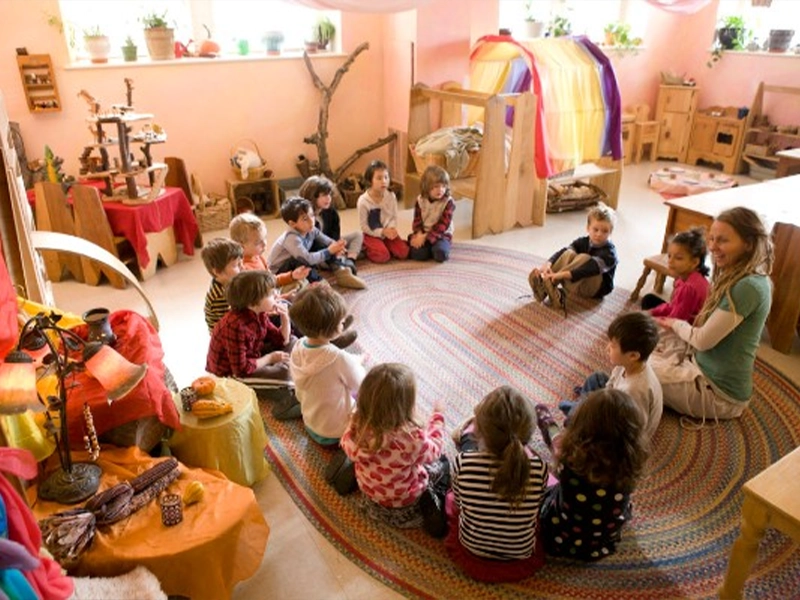
Tworzenie środowiska edukacyjnego inspirowanego metodą Waldorfa
Sala lekcyjna inspirowana pedagogiką waldorfską jest starannie zaprojektowana, aby odzwierciedlać istotę metody nauczania waldorfskiego. Każdy szczegół – od koloru ścian po dobór mebli – odgrywa rolę we wspieraniu nauki i dobrego samopoczucia dzieci. Przyjrzyjmy się najważniejszym aspektom tworzenia przestrzeni, w której edukacja waldorfska może się naprawdę rozwijać.
Dlaczego środowisko klasowe ma znaczenie w edukacji waldorfskiej
W metodzie nauczania Waldorfa środowisko klasowe jest postrzegane jako przedłużenie procesu uczenia się. Szkoły waldorfskie rozumieją, że dzieci przyswajają więcej niż tylko to, czego się uczą – każdego dnia są pod silnym wpływem otoczenia.
- Klasa jako „trzeci nauczyciel”:
W edukacji waldorfskiej fizyczna sala lekcyjna nie jest jedynie tłem, ale aktywną częścią zespołu nauczycielskiego. Przestrzeń ta delikatnie kształtuje zachowanie i nastawienie dzieci. Kiedy sala lekcyjna waldorfska jest zorganizowana z rozmysłem, naturalnie sprzyja skupieniu, kreatywności i współpracy między uczniami. Dlatego wiele szkół waldorfskich inwestuje w starannie przemyślany układ, delikatne oświetlenie i uporządkowane przestrzenie. - Spokojne, przyjazne przestrzenie:
Sale lekcyjne waldorfskie unikają jaskrawych kolorów i ostrego światła. Zamiast tego, dominują w nich delikatne barwy, naturalne światło słoneczne i wiele cichych zakątków. Takie otoczenie pomaga dzieciom czuć się bezpiecznie i komfortowo, co z kolei zachęca je do eksploracji, zadawania pytań i próbowania nowych rzeczy. Spokojne otoczenie jest znakiem rozpoznawczym edukacji waldorfskiej i jest ściśle związane z sukcesem tej metody nauczania. - Ruch i elastyczność:
W przeciwieństwie do tradycyjnych sal lekcyjnych, sale waldorfskie nie są stałe. Meble można przesuwać, aby stworzyć przestrzeń do pracy w grupach, zajęć w kręgu lub kreatywnej zabawy. Elastyczne układy sprzyjają zarówno niezależności, jak i współpracy. Dzieci są zachęcane do aktywnego udziału w aranżacji swojej klasy, co uczy odpowiedzialności i szacunku do przestrzeni wspólnej – kluczowej wartości w szkołach waldorfskich. - Połączenie ze zmysłami:
Każdy element, od faktury wełnianego dywanu po zapach drewnianych półek, został dobrany tak, aby wspierać rozwój sensoryczny dzieci. Metoda nauczania waldorfskiego zachęca nauczycieli do stosowania materiałów, które zachęcają do dotyku i interakcji. Te doświadczenia sensoryczne osadzają dzieci w teraźniejszości i pomagają im poczuć więź z otoczeniem. - Wspieranie programu nauczania Waldorf:
Przemyślana sala lekcyjna wspiera wszystkie elementy programu nauczania waldorfskiego. Niezależnie od tego, czy chodzi o opowiadanie historii w przytulnym kąciku, malowanie przy nasłonecznionym stole, czy wspólne śpiewanie porannych piosenek, otoczenie wzbogaca każde doświadczenie edukacyjne. Metoda nauczania waldorfskiego przypomina nam, że dzieci rozwijają się, gdy ich sale lekcyjne są tak samo inspirujące i wspierające, jak same lekcje.
Wybór odpowiednich materiałów i mebli do sal lekcyjnych waldorfskich
Wybór prawe meble i materiały są kluczowym elementem tworzenia autentycznej klasy waldorfskiej. Podejmowane przez Ciebie decyzje wpłyną nie tylko na wygląd i atmosferę szkoły, ale także na to, jak dzieci uczą się i wchodzą w interakcje każdego dnia.
- Naturalne materiały w sercu designu waldorfskiego:
Szkoły i przedszkola waldorfskie preferują naturalne materiały, takie jak drewno, wełna i bawełna, do produkcji mebli i wyposażenia sal lekcyjnych. Krzesła z litego drewna, stoliki dziecięce i półki z naturalnego drewna to powszechne wybory. Te elementy są nie tylko trwałe i bezpieczne, ale także pomagają dzieciom w kontakcie z naturą, co jest kluczową ideą filozofii edukacji waldorfskiej. Często można również znaleźć wełniane dywany, bawełniane zasłony i ręcznie tkane kosze. - Meble ergonomiczne i dostosowane do potrzeb dzieci:
Metoda nauczania waldorfskiego ceni niezależność, dlatego meble dobierane są z myślą o dziecku. Szukaj niskich stolików, małych drewnianych krzeseł, otwartych regałów na książki i wieszaków na ubrania umieszczonych na wysokości dziecka. Ergonomiczna konstrukcja sprzyja prawidłowej postawie i zdrowemu ruchowi, co jest kluczowe w pedagogice waldorfskiej. - Prostota i wszechstronność:
W klasach waldorfskich meble i materiały są proste, aby zachęcać do swobodnej zabawy. Stojaki do zabawy (drewniane ramy do wieszania jedwabi lub tworzenia kreatywnych scen) mogą stać się teatrzykiem lalkowym, sklepikiem lub kącikiem do czytania. Sztalugi malarskie, duże plecione kosze na klocki i sztaplowane stołki oferują wiele zastosowań i wspierają waldorfską metodę nauczania. - Bezpieczeństwo i zrównoważony rozwój:
Bezpieczeństwo jest zawsze priorytetem. Szkoły waldorfskie wybierają meble o gładkich krawędziach, stabilnych podstawach i nietoksycznym wykończeniu. Zrównoważona produkcja jest również niezbędna, zgodna z zasadami Waldorfa, dotyczącymi poszanowania środowiska naturalnego. Rozważ wybór rozwiązań przyjaznych dla środowiska. meble drewniane, bambusowe półki do przechowywania lub produkty z certyfikatem FSC do Twojej klasy. - Harmonia estetyczna:
Każdy element wyposażenia sali waldorfskiej został dobrany tak, aby podkreślać poczucie piękna i porządku. Spójne kolory, miękkie tkaniny i naturalne faktury tworzą spokojną atmosferę. W pomieszczeniu często można spotkać wełniane dywaniki, bawełniane poduszki i elementy dekoracyjne inspirowane naturą.
Lista kontrolna produktów dla klasy waldorfskiej
| Typ produktu | Opis / Zastosowanie | Waldorf Features |
|---|---|---|
| Drewniane stoliki dla dzieci | Do pracy grupowej, posiłków i zajęć artystycznych | Naturalne materiały, ergonomiczny design |
| Krzesła drewniane | Wspiera prawidłową postawę i niezależność | Solidny, odpowiedni dla dzieci, łatwy do przenoszenia |
| Otwarte regały/regały na książki | Przechowywanie książek, zabawek i materiałów szkolnych | Niska wysokość zapewniająca łatwy dostęp, naturalne drewno |
| Stoiska do zabawy / Teatry lalkowe | Do kreatywnej zabawy i tworzenia scen | Wszechstronny, zachęca do kreatywności |
| Sztalugi artystyczne i stoły do robótek ręcznych | Malarstwo, rysunek i rzemiosło | Regulowany, łatwy do czyszczenia |
| Duże plecione kosze | Zorganizuj klocki, zabawki i artykuły artystyczne | Miękkie, naturalne włókna, elastyczne zastosowanie |
| Dywaniki wełniane lub bawełniane | Określ przestrzenie grupowe i kąciki czytelnicze | Miękka tekstura, naturalne kolory |
| Poduszki podłogowe i worki sako | Stwórz przytulne, zachęcające miejsca do czytania lub odpoczynku | Wygodne, bezpieczne materiały |
| Stoły/półki wystawowe Nature | Pokaż przedmioty sezonowe i kolekcje przyrodnicze | Łączy klasę z naturą |
| Wieszaki na ubrania na wysokości dziecka | Wspieranie niezależności i porządku | Prawidłowy wzrost dla dbania o siebie |
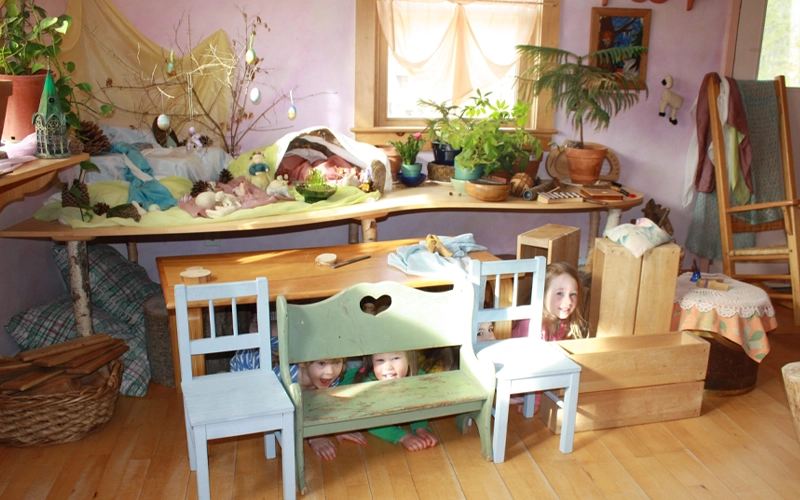
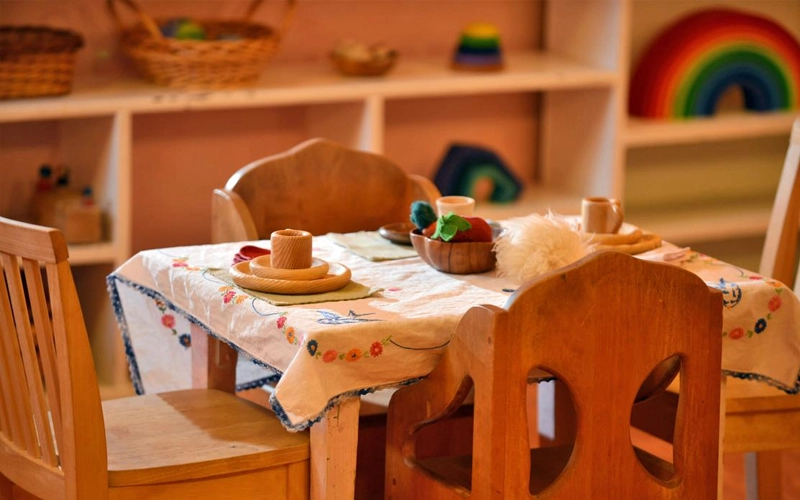
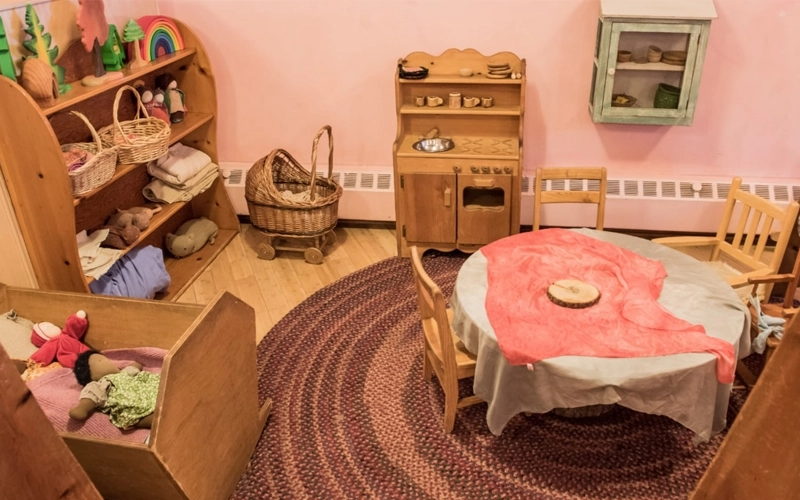
Projektowanie otwartych przestrzeni do zabawy i nauki
Kluczową cechą metody nauczania Waldorf jest zapewnienie przestrzeni na swobodną zabawę i praktyczną eksplorację. W klasach waldorfskich nauczyciele stosują przemyślane rozwiązania i wszechstronne produkty, aby pobudzać wyobraźnię i rozwijać się społecznie.
- Elastyczne przestrzenie do kreatywnej zabawy:
Szkoły waldorfskie chętnie korzystają ze stojaków do zabawy, które mogą stać się sklepikiem, teatrem lub przytulną kryjówką, wystarczy kilka jedwabnych apaszek lub kawałków materiału. Drewniane klocki, skrzynki do układania w stosy i proste stoły pozwalają dzieciom zaprojektować własne światy zabaw. - Proste, wielofunkcyjne materiały:
Zabawki i rekwizyty w klasach waldorfskich są dobierane ze względu na ich wszechstronność. Lalki waldorfskie, drewniane zwierzątka, plecione kosze, filcowe maty i jedwabne chusty pozwalają dzieciom wymyślać własne historie, budować scenografię i odkrywać ruch. To wspiera waldorfską filozofię uczenia się przez działanie. - Brak ekranów i zabawek na baterie:
Zgodnie z pedagogiką waldorfską, w klasie nie ma żadnych gadżetów elektronicznych. Zamiast tego dzieci intensywnie angażują się w drewniane puzzle, przedmioty inspirowane naturą i kreatywne materiały plastyczne. - Strefy różnych aktywności:
Pomieszczenia zaaranżowano z myślą o różnorodnym przeznaczeniu: jest tu kącik do czytania z poduszkami na podłodze i niską półką na książki, strefa budowania z plastrami drzewa i koszami z luźnymi częściami, stół artystyczny z farbami i gliną oraz scena kukiełkowa do opowiadania historii. - Wspieranie rozwoju społecznego i emocjonalnego:
Dzięki tym otwartym zasobom dzieci w naturalny sposób uczą się współpracy, dzielenia się i komunikacji, co jest cechą charakterystyczną pedagogiki waldorfskiej.
Typowe produkty do zabawy i nauki waldorfskiej:
| Produkt | Użyj w klasie |
|---|---|
| Stojaki do zabawy | Budowanie fortów, sklepów, teatrów lalkowych |
| Drewniane klocki | Kreatywne budowanie, liczenie i sortowanie |
| Szale i tkaniny jedwabne | Kostiumy, ruch, scenografia do kreatywnej zabawy |
| Lalki i marionetki Waldorf | Opowiadanie historii, odgrywanie ról, nauka społeczna |
| Kosze tkane | Przechowywanie zabawek, przedmiotów naturalnych lub materiałów artystycznych |
| Poduszki i dywaniki podłogowe | Przytulne miejsca do czytania, odpoczynku lub wspólnego spędzania czasu |
| Sztalugi artystyczne i stoły do robótek ręcznych | Malowanie, rysowanie, projekty wspólne |
| Niskie półki i regały na książki | Dostępne miejsce do przechowywania, ekspozycja książek dla dzieci |
| Plastry drzew i luźne części | Budowanie, układanie, eksploracja oparta na naturze |
Te otwarte produkty pomagają wcielić w życie metodę nauczania Waldorfa, zmieniając każdą klasę w miejsce, w którym kreatywność, niezależność i odkrywanie są częścią codziennego życia.
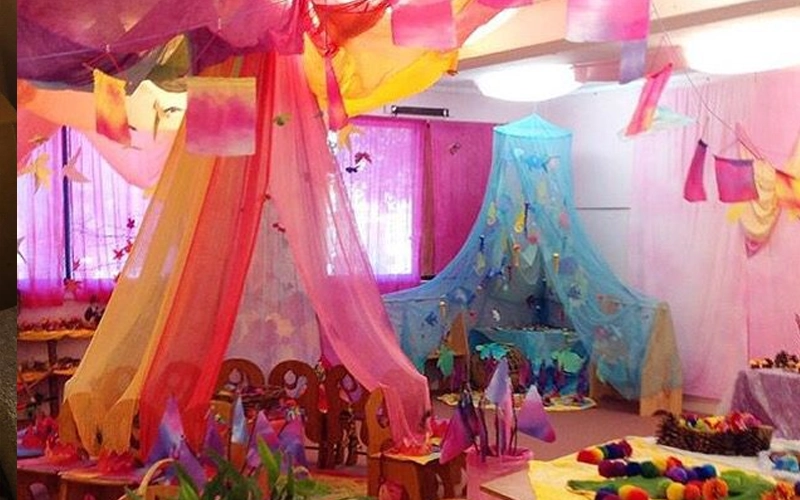
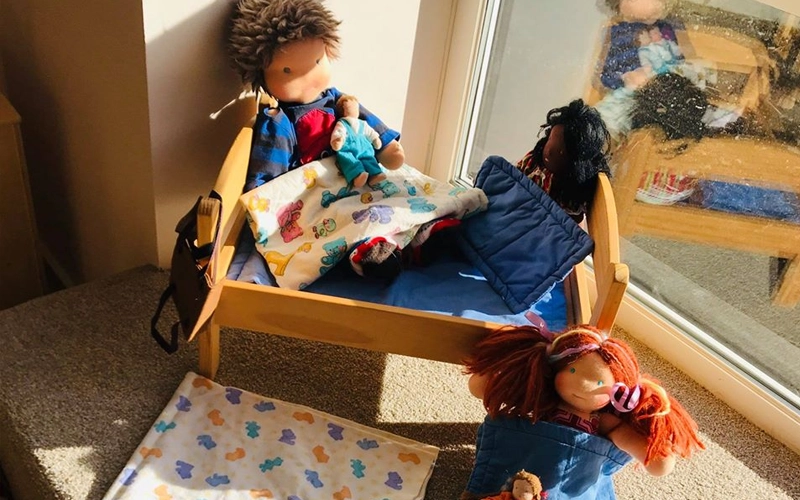

Wprowadzanie natury i rytmu pór roku do klasy
Metoda nauczania waldorfskiego kładzie duży nacisk na więź dzieci z naturą i szacunek dla rytmu pór roku. W klasie waldorfskiej otoczenie jest starannie zaprojektowane, aby odzwierciedlać cykle świata przyrody, co stanowi kluczowy element pedagogiki i filozofii waldorfskiej.
- Stoły przyrodnicze i wystawy sezonowe:
W szkołach i przedszkolach waldorfskich centralnym punktem jest stół poświęcony naturze. Dzieci zbierają i eksponują przedmioty sezonowe, takie jak kamienie, liście i kwiaty, zamieniając salę lekcyjną w żywe odbicie zmian zachodzących w przyrodzie. Ta praktyczna aktywność jest znakiem rozpoznawczym metody nauczania waldorfskiego i wspiera waldorfskie podejście do nauki, zachęcając do obserwacji i szacunku do ziemi. - Maksymalne wykorzystanie światła naturalnego i życia roślin:
Typowa sala lekcyjna waldorfska jest wypełniona światłem słonecznym i świeżym powietrzem, co sprzyja dobremu samopoczuciu i nauce dzieci. Rośliny i ogrody wewnętrzne są powszechne w szkołach waldorfskich, pomagając uczniom uczyć się troski o żywe organizmy. Nauczyciele w szkołach waldorfskich mogą wykorzystywać kryształy okienne lub łapacze słońca, aby wprowadzić do pomieszczenia naturalne kolory i piękno. - Sezonowe rzemiosło i naturalne dekoracje:
Program nauczania waldorfskiego obejmuje wiele zajęć rękodzielniczych z wykorzystaniem wełny, filcu i drewna. Dzieci tworzą dekoracje i projekty artystyczne nawiązujące do każdej pory roku, takie jak wiosenne girlandy czy jesienne mobile. Ta twórcza aktywność jest kluczowa dla metody waldorfskiej i pomaga budować rytm zajęć w klasie waldorfskiej. - Nauka na świeżym powietrzu i spacery pośród natury:
Podejście waldorfskie promuje regularne spędzanie czasu na świeżym powietrzu, czy to w szkolnym ogrodzie, czy na spacerach pośród natury. Doświadczenia te są głęboko zakorzenione w systemie edukacji waldorfskiej, pomagając dzieciom uczyć się poprzez bezpośrednie doświadczenie i wzmacniając wartości metody nauczania waldorfskiej. - Rytmy dzienne i tygodniowe:
Nauczyciele kierujący się filozofią edukacji waldorfskiej planują rutyny i święta sezonowe w zgodzie z rytmem natury. Poranne kręgi, cotygodniowe pieczenie ciast i celebracje sezonowe to klasyczne przykłady działania systemu waldorfskiego.
W każdej klasie waldorfskiej te naturalne elementy i rytmy ożywiają naukę. Metoda nauczania waldorfskiego uczy dzieci dostrzegania otaczającego je świata i poczucia się częścią czegoś większego – co stanowi istotny element unikalnej charakterystyki edukacji waldorfskiej.
Twoja idealna klasa jest tylko jedno kliknięcie stąd!
Wspieranie niezależności i kreatywności poprzez układ
Kluczowym celem metody nauczania Waldorf jest wspieranie dzieci w rozwijaniu umiejętności samodzielnego myślenia i kreatywnego rozwiązywania problemów. Sposób organizacji sali lekcyjnej w Waldorfie może znacząco wpłynąć na wspieranie niezależności i kreatywności każdego dziecka.
- Dostępne meble i materiały:
W szkołach waldorfskich wszystkie stoły, krzesła, półki i szafki są ustawione na wysokości dostosowanej do potrzeb dzieci. Zachęca to dzieci do znajdowania potrzebnych rzeczy, sprzątania po zajęciach i podejmowania własnych decyzji w ciągu dnia. Sala lekcyjna waldorfska została zaprojektowana tak, aby dawać dzieciom poczucie sprawczości i promować pewność siebie, co jest podstawową zasadą filozofii edukacji waldorfskiej. - Otwarte układy umożliwiające swobodne przemieszczanie się:
Metoda nauczania Waldorf zaleca otwarte przestrzenie z wyraźnymi ciągami komunikacyjnymi. Meble są ustawione tak, aby dzieci mogły swobodnie przemieszczać się między strefami aktywności, takimi jak place zabaw, kąciki czytelnicze i stoły do zajęć plastycznych. Ta swoboda sprzyja kreatywnej eksploracji, współpracy i koordynacji ruchowej, które są cenione w pedagogice Waldorf. - Wybór i elastyczność:
Metoda waldorfska pozwala dzieciom samodzielnie decydować, gdzie i jak pracują lub bawią się. Posiadanie wielu przestrzeni – takich jak cichy kącik do czytania, duży stół do grupowej pracy plastycznej czy otwarta przestrzeń do budowania – pozwala uczniom rozwijać swoje zainteresowania i wyrażać swoją indywidualność. To wspiera unikalne cechy metody waldorfskiej. - Działania samodzielne:
Nauczyciele stosujący model edukacji waldorfskiej zachęcają do samodzielnych projektów i zadań otwartych. Materiały są prezentowane w uporządkowany i zachęcający sposób, dzięki czemu dzieci mogą samodzielnie rozpoczynać zajęcia i sprzątać po ich zakończeniu. Taka rutyna pomaga uczniom rozwijać poczucie odpowiedzialności i przynależności do grupy w klasie. - Zachęcanie do współpracy:
Choć niezależność jest kluczowa, układ sprzyja również pracy zespołowej. Miejsca siedzące w grupach, wspólne materiały i otwarte przestrzenie do wspólnego spędzania czasu lub występów dają uczniom możliwość wspólnej pracy, dzielenia się pomysłami i wspólnego rozwiązywania problemów – co jest centralnym aspektem systemu edukacji waldorfskiej.
Dzięki przemyślanemu układowi klasy metoda nauczania Waldorf tworzy środowisko, w którym dzieci rozwijają umiejętności życiowe, samomotywację i pewność siebie w działaniu — cechy, które pozostają z nimi na długo po okresie przedszkolnym.
Integracja obszarów nauki na świeżym powietrzu
W metodzie nauczania Waldorf nauka nie kończy się za drzwiami klasy. Przestrzenie zewnętrzne są postrzegane jako istotne rozszerzenie środowiska szkoły waldorfskiej, oferując dzieciom świeże powietrze, ruch i nieograniczone możliwości kontaktu z naturą.
- Projektuj sale lekcyjne na świeżym powietrzu, mając na uwadze naturę
Szkoły waldorfskie często tworzą ogrody, piaskownice lub ciche zakątki na świeżym powietrzu. Wykorzystuj naturalne materiały – takie jak drewniane ławki, pnie drzew jako siedziska czy bambusowe ogrodzenia – aby przestrzeń na zewnątrz harmonizowała z filozofią waldorfską. - Zaplanuj działania sezonowe
Zaplanuj czas na spacery pośród natury, prace w ogrodzie i święta sezonowe. Dzieci mogą sadzić cebulki wiosną, zbierać liście jesienią lub budować śnieżne forty zimą. Nauka na świeżym powietrzu wspiera rytm i doświadczenia sensoryczne, które są tak ważne w pedagogice waldorfskiej. - Zapewnij otwarte materiały do zabawy na zewnątrz
Zaoferuj luźne elementy, takie jak kłody, kamienie, gałęzie i liny, do budowania i odkrywania. Unikaj plastikowych elementów wyposażenia placu zabaw – naturalne elementy lepiej pasują do metody waldorfskiej i pobudzają kreatywność. - Stwórz osłonięte przestrzenie
Zadbaj o zacienione miejsce lub proste schronienie na zewnątrz, aby dzieci mogły uczyć się i bawić na świeżym powietrzu bez względu na pogodę. Tablice kredowe, niskie stoliki i stanowiska do rysowania w plenerze urozmaicą zajęcia na świeżym powietrzu. - Wspieraj eksplorację i niezależność
Nauka na świeżym powietrzu w edukacji waldorfskiej polega na dawaniu dzieciom swobody eksploracji. Bezpieczne granice, widoczni nauczyciele i proste zasady pozwalają dzieciom podejmować ryzyko i uczyć się we własnym tempie. - Rozszerz program nauczania Waldorf na zajęcia na świeżym powietrzu
Wiele szkół waldorfskich przenosi zajęcia w pomieszczeniach na zewnątrz – poranne kółko, opowiadanie historii, malowanie, a nawet przekąski mogą odbywać się na świeżym powietrzu. To rozszerzenie wzmacnia unikalne cechy metody nauczania waldorfskiej.
Przemyślane zintegrowanie obszarów nauki na świeżym powietrzu pomoże dzieciom rozwijać się, wesprze ich całościowy rozwój i pozwoli w pełni wprowadzić metodę nauczania Waldorf w życie w szkole lub przedszkolu.
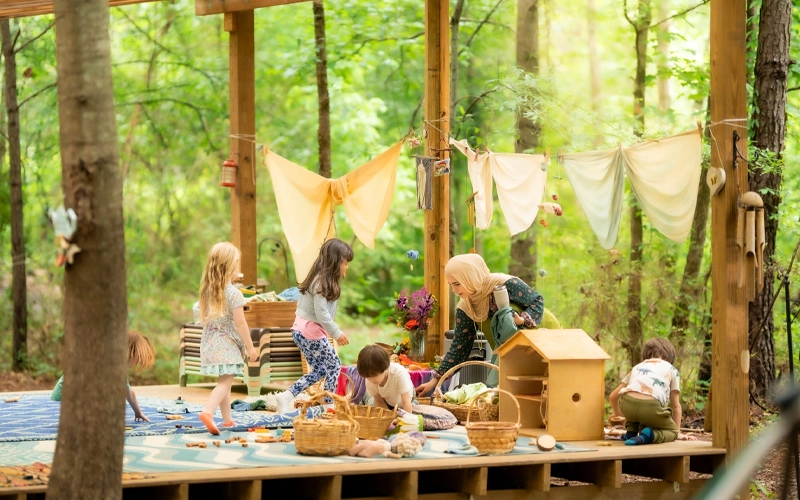
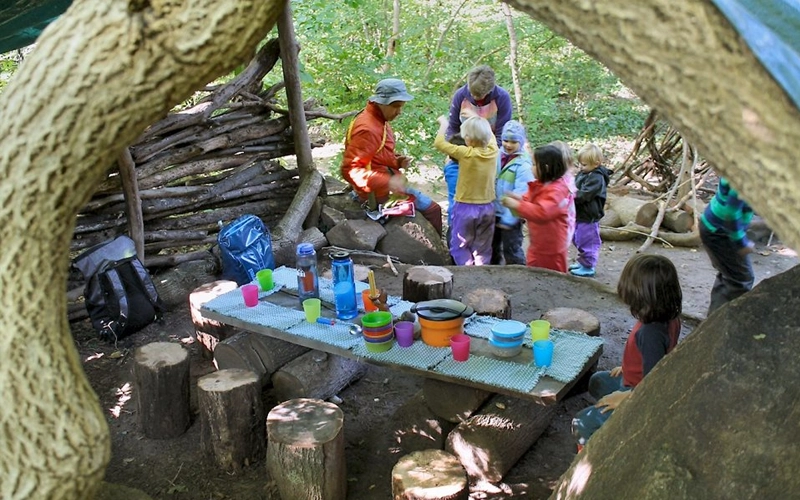
Praktyczne wskazówki dotyczące tworzenia klasy inspirowanej edukacją waldorfską
Przygotowanie sali lekcyjnej w stylu waldorfskim wymaga czegoś więcej niż tylko wyboru pięknych mebli. Metoda nauczania waldorfskiego opiera się na tworzeniu środowiska, które wspiera rozwój każdego dziecka – umysłu, ciała i ducha. Oto kilka praktycznych wskazówek dla każdego, kto przygotowuje salę lekcyjną lub przedszkole waldorfskie:
- Zacznij od jasnego planu:
Zanim wniesiesz jakiekolwiek meble, zastanów się, jak będzie wykorzystywana sala lekcyjna waldorfska w ciągu dnia. Weź pod uwagę rytm dnia i pory roku, zajęcia grupowe, ciche zakątki i przestrzeń do ruchu. Pedagogika waldorfska ceni elastyczność i płynność. - Daj priorytet materiałom naturalnym:
Wybierz stoły i krzesła z litego drewna, bawełniane lub wełniane dywany oraz zasłony z naturalnych włókien. Materiały te pomagają stworzyć spokojną, przyjazną i zdrową atmosferę w szkole waldorfskiej. Unikaj plastiku i metalu, jeśli to możliwe, aby pozostać wiernym filozofii edukacji waldorfskiej. - Utwórz zdefiniowane strefy:
Wykorzystaj półki i meble, aby zorganizować klasę w strefach do zabawy, zajęć plastycznych, czytania i pracy w grupach. W metodzie nauczania Waldorfa wyraźne podziały stref podkreślają unikalną charakterystykę tej metody. - Zachowaj prostotę i rytmiczność wystroju:
Unikaj bałaganu i jaskrawych dekoracji. Zamiast tego postaw na sezonowe rękodzieło, stoliki z motywami natury i stonowane kolory. Podejście waldorfskie zakłada, że wizualny rytm pomaga dzieciom czuć się bezpiecznie i zainspirować. - Użyj mebli w rozmiarze dziecięcym i otwartych schowków:
Niskie stoliki, krzesełka i półki dają dzieciom niezależność. Mogą samodzielnie sięgać po materiały, co jest kluczowe dla szkół waldorfskich i filozofii nauczania waldorfskiego. - Plan ruchu:
Zadbaj o wystarczającą ilość otwartej przestrzeni na zabawę w kręgu, gry i zajęcia kreatywne. Metoda edukacji waldorfskiej promuje ruch jako element codziennej rutyny. - Ułatw konserwację:
Wybierz zmywalne pokrowce, solidne meble i kosze do przechowywania, aby utrzymać porządek i czystość w klasie. Metoda nauczania Waldorf ceni estetykę, ale musi być praktyczna dla zapracowanych nauczycieli i aktywnych dzieci. - Skonsultuj się z dostawcami mebli Waldorf:
W razie wątpliwości skontaktuj się z dostawcami, którzy znają się na systemie Waldorf i mogą polecić produkty odpowiadające Twojej wizji i programowi nauczania Waldorf.
Stworzenie klasy inspirowanej pedagogiką waldorfską to inwestycja w przyszłość każdego dziecka. Kierując się metodą nauczania waldorfskiego, tworzysz przestrzeń, w której dzieci mogą się rozwijać, dokładnie tak, jak zamierzały to szkoły Rudolfa Steinera i waldorfskie.
Przewodnik krok po kroku: Zakładanie klasy waldorfskiej
Przygotowanie sali lekcyjnej w stylu waldorfskim może początkowo wydawać się przytłaczające, ale dzięki prostemu procesowi krok po kroku staje się ono proste i skuteczne. Metoda nauczania waldorfskiego kładzie nacisk na przemyślane planowanie, naturalne materiały i elastyczność. Oto praktyczny przewodnik, który pomoże Ci stworzyć ciepłą i inspirującą salę lekcyjną w stylu waldorfskim od podstaw:
Krok 1: Określ cel zajęć i rytm dnia
- Zdecyduj, czy przestrzeń będzie przeznaczona dla przedszkola waldorfskiego, zerówki czy klasy podstawowej.
- Naszkicuj swój codzienny i cotygodniowy rytm, uwzględniając czas na swobodną zabawę, czas spędzony w kręgu, sztukę, opowiadanie historii i zajęcia na świeżym powietrzu.
- Filozofia pedagogiczna szkoły waldorfskiej ceni rutynę i zmiany, które pomagają dzieciom czuć się bezpiecznie.
Krok 2: Wybierz spokojną, jasną przestrzeń
- Jeśli to możliwe, wybieraj pomieszczenie z dostępem do naturalnego światła słonecznego i dobrą wentylacją.
- Przytulna atmosfera panująca w klasie waldorfskiej jest potęgowana przez stonowane kolory ścian i proste osłony okienne.
- Ustaw meble tak, aby maksymalnie wykorzystać naturalne światło, a także rozważ dodanie roślin lub kryształów okiennych.
Krok 3: Wybierz naturalne meble w rozmiarze dziecięcym
- Zainwestuj w stoły z litego drewna, krzesełka dla dzieci, otwarte półki i kosze do przechowywania.
- Utrzymuj przejścia w czystości i upewnij się, że każde dziecko może samodzielnie dotrzeć do potrzebnych rzeczy, zgodnie z pedagogiką waldorfską i wspierając niezależność.
- Stwórz kąciki czytelnicze, stoły do rysowania i stoły przyrodnicze w miejscach, w których dzieci naturalnie się gromadzą.
Krok 4: Zorganizuj strefy aktywności
- Za pomocą półek lub dywaników wyznacz strefy przeznaczone do budowania, czytania, sztuki, muzyki i kreatywnej zabawy.
- Zadbaj o to, aby każda strefa była elastyczna, tak aby można ją było zmieniać w zależności od zainteresowań dzieci i potrzeb klasy.
- Metoda nauczania Waldorfa stawia na różnorodność — nie należy przepełniać klasy, ale pozostawić przestrzeń na ruch i odkrywanie.
Krok 5: Dodaj materiały do zabawy otwartej i dekoracje sezonowe
- W zestawie znajdują się stojaki do zabawy, drewniane klocki, jedwabne szale, lalki waldorfskie i artykuły rzemieślnicze.
- Wymieniaj materiały i aktualizuj tablice informacyjne o przyrodzie lub wystawy sezonowe w ciągu roku, aby odzwierciedlały zmiany zachodzące w przyrodzie.
- W szkole waldorfskiej cenione jest piękno i rytm, dlatego eksponuj prace plastyczne dzieci i własnoręcznie wykonane dekoracje.
Krok 6: Utrzymuj porządek i organizację przestrzeni
- Naucz dzieci dbałości o klasę poprzez odkładanie przedmiotów na miejsce po użyciu.
- Aby ułatwić dostęp i sprzątanie, używaj koszyków, tacek i opisanych półek.
- Uporządkowane środowisko sprzyja wykorzystaniu unikalnych cech klasy waldorfskiej i metody nauczania waldorfskiego.
Krok 7: Stwórz powitalny wpis i skontaktuj się z rodzinami
- Stwórz przyjazne wejście z wieszakiem na ubrania, półką na buty i miejscem do komunikacji z rodzicami.
- Wyświetl codzienny harmonogram, nadchodzące wydarzenia i sezonowe wiadomości, aby rodziny mogły je zobaczyć.
- System edukacji waldorfskiej promuje silną współpracę szkoły i domu.
Szybkie wskazówki:
- Zacznij od czegoś prostego i rozwijaj w miarę postępów — każda klasa waldorfska ewoluuje.
- Zaangażuj nauczycieli, dzieci i rodziców w dekorowanie i utrzymanie tej przestrzeni.
- Skontaktuj się z dostawcami mebli Waldorf, aby uzyskać rozwiązania dostosowane do Twoich potrzeb.
Dzięki starannemu planowaniu i otwartemu umysłowi każdy może wykorzystać metodę nauczania Waldorfa do stworzenia klasy, w której dzieci czują się zainspirowane, docenione i gotowe do nauki każdego dnia.
Nie tylko o tym marz, zaprojektuj to! Porozmawiajmy o Twoich potrzebach w zakresie mebli na zamówienie!
Typowe błędy, których należy unikać w organizacji klasy waldorfskiej
Założenie klasy waldorfskiej może być zarówno ekscytujące, jak i trudne. Metoda nauczania waldorfskiego jest wyjątkowa i nawet doświadczeni nauczyciele lub dyrektorzy szkół mogą popełniać błędy, jeśli dopiero zaczynają swoją przygodę z edukacją waldorfską. Oto kilka najczęstszych pułapek, których należy unikać:
- Używanie zbyt wielu materiałów komercyjnych lub plastikowych
Jednym z największych błędów w szkołach waldorfskich jest wypełnianie klas kolorowymi plastikowymi zabawkami i produktami komercyjnymi. Filozofia waldorfska ceni naturalne, proste materiały, które pobudzają wyobraźnię. Zawsze wybieraj drewno, bawełnę, wełnę i inne naturalne włókna do mebli i materiałów edukacyjnych w klasie. - Przepełnienie przestrzeni
Próba umieszczenia zbyt wielu mebli lub zabawek może sprawić, że klasa będzie sprawiać wrażenie zagraconej i przytłaczającej. Podejście waldorfskie opiera się na zasadzie „mniej znaczy więcej”. Zachowaj otwarte przestrzenie do swobodnej zabawy i ruchu oraz wymieniaj zabawki i przybory przez cały rok, zamiast wystawiać wszystko naraz. - Ignorowanie rytmu i rutyny
Klasy waldorfskie potrzebują stałego rytmu, aby dzieci czuły się bezpiecznie i mogły się skupić. Pomijanie codziennych lub sezonowych czynności może wywoływać u uczniów niepokój i zaburzać waldorfską metodę nauczania. Zaplanuj regularne spotkania w kręgu, opowiadanie historii, sezonowe prace plastyczne i zmiany. - Zapominając o znaczeniu natury
Kolejnym częstym błędem jest niedostateczne włączanie do klasy elementów przyrody. Prawdziwa sala lekcyjna waldorfska powinna odzwierciedlać pory roku, a stoły, rośliny i dekoracje inspirowane naturą stanowią kluczowe elementy metody nauczania waldorfskiej. - Zaniedbywanie komfortu nauczyciela i ucznia
Nie zapominajmy o komforcie nauczycieli i dzieci. Meble dostosowane do potrzeb dzieci, delikatne oświetlenie i przytulne miejsca do czytania sprawiają, że wszyscy czują się jak w domu, co jest kluczowe dla filozofii edukacji waldorfskiej. - Konsultacja z ekspertami w sprawie pomijania
Czasami szkoły próbują samodzielnie zaaranżować pokój waldorfski bez konsultacji z osobami zaznajomionymi z pedagogiką waldorfską. Może to prowadzić do niewłaściwych wyborów dotyczących aranżacji lub zakupu nieodpowiednich produktów. W miarę możliwości należy współpracować z doświadczonymi dostawcami mebli i edukatorami waldorfskimi. - Brak elastyczności
Zbyt sztywne trzymanie się jednego układu sali lub nadmierne planowanie może ograniczać kreatywność i naturalny przepływ. Klasa waldorfska powinna ewoluować wraz z rozwojem i zmianami dzieci – bądź gotowy na dostosowanie jej układu w razie potrzeby.
Unikanie tych błędów pomoże Ci stworzyć przyjazną, kreatywną i wspierającą środowisko w klasie waldorfskiej, które rzeczywiście wspiera metodę nauczania waldorfską.
Jak włączyć program nauczania waldorfskiego do programu przedszkolnego?
Jeśli rozważasz wprowadzenie metody edukacji waldorfskiej do swojego przedszkola, musisz podjąć kilka ważnych kroków, aby dostosować ją do zasad pedagogiki waldorfskiej.
Utwórz spójny harmonogram
Klasy waldorfskie są znane ze swoich ustrukturyzowanych, ale elastycznych harmonogramów. Przewidywalny rytm dnia daje dzieciom poczucie bezpieczeństwa i pomaga im płynnie przechodzić między zajęciami. Czas w kręgu, opowiadanie historii i zadania praktyczne, takie jak pieczenie lub ogrodnictwo, powinny być zintegrowane z dniem, aby stworzyć zrównoważone i angażujące doświadczenie edukacyjne.
Metoda nauczania Waldorf kładzie duży nacisk na rytm i rutynę. W przedszkolu Waldorf dzieci stosują przewidywalny, spójny harmonogram, który obejmuje czas na kreatywną zabawę, zadania praktyczne, zajęcia artystyczne i cichą refleksję. Ten rytm pomaga dzieciom czuć się bezpiecznie i pewnie, zapewniając solidne podstawy do nauki i rozwoju osobistego.
Dodaj naturalne zabawki i meble
Filozofia nauczania waldorfskiego kładzie duży nacisk na wykorzystanie materiałów naturalnych. Klasy waldorfskie są wypełnione drewnianymi meblami, ręcznie robionymi lalkami i naturalnymi włóknami, takimi jak wełna i bawełna. Prostota tych materiałów pomaga zmniejszyć nadmierną stymulację i zachęca dzieci do głębszego angażowania się w kreatywną zabawę.
W przedszkolu waldorfskim środowisko jest kluczowe dla procesu uczenia się. Program nauczania waldorfskiego zaleca używanie zabawek wykonanych z naturalnych materiałów, które są dotykowe, proste i otwarte, pozwalając dzieciom na swobodne eksplorowanie i używanie wyobraźni. Unikaj plastikowych lub komercyjnych zabawek, które mogą dyktować, jak należy się nimi bawić. Zamiast tego używaj zabawek, które umożliwiają dzieciom zabawę w udawanie, opowiadanie historii i współpracę z rówieśnikami.
Zachęcaj do praktycznych umiejętności życiowych
Włączenie umiejętności życiowych, takich jak gotowanie, sprzątanie i majsterkowanie, do programu nauczania Waldorf pozwala dzieciom rozwijać odpowiedzialność, niezależność i umiejętności motoryczne. Te zajęcia to nie tylko obowiązki — to doświadczenia edukacyjne, które wzmacniają poczucie spełnienia i wspólnoty.
Metoda nauczania Waldorf uważa te praktyczne zadania za niezbędne dla rozwoju dziecka. W klasie Waldorf dzieci mogą pomagać w przygotowywaniu przekąsek, przygotowywać pokój na zajęcia w ciągu dnia lub pomagać w sprzątaniu po zabawie. Zajęcia te uczą podstawowych umiejętności życiowych, promują pracę zespołową i dają dzieciom poczucie odpowiedzialności i przynależności do społeczności klasowej.
Odkryj naturę z dziećmi
Zabawa na świeżym powietrzu jest centralnym punktem filozofii edukacji waldorfskiej. Niezależnie od tego, czy jest to spacer po naturze, ogrodnictwo czy swobodna zabawa w naturalnym środowisku, te zajęcia pomagają dzieciom budować więź z naturą, co jest istotnym elementem edukacji waldorfskiej. Regularny kontakt z naturą wzmacnia poczucie zachwytu, ciekawości i odpowiedzialności za środowisko.
Przedszkole waldorfskie często obejmuje zajęcia sezonowe, które odzwierciedlają rytmy świata przyrody, takie jak sadzenie nasion wiosną, zbieranie liści jesienią lub budowanie rzeźb ze śniegu zimą. Te zajęcia na świeżym powietrzu zachęcają do aktywności fizycznej i pogłębiają uznanie dzieci dla otaczającego je świata. Świat przyrody jest postrzegany jako najlepsza klasa w edukacji waldorfskiej, oferująca nieskończone możliwości eksploracji i nauki.
Czym szkoła waldorfska różni się od zwykłej szkoły?
Edukacja waldorfska różni się od tradycyjnej edukacji w kilku kluczowych obszarach, w szczególności w podejściu rozwojowym, metodologii nauczania i ogólnej filozofii. Oto, czym szkoły waldorfskie różnią się od zwykłych szkół:
- Czy metodę waldorfską można dostosować do nowoczesnych klas?
Metoda edukacji waldorfskiej zniechęca do korzystania z technologii, podczas gdy nowoczesne klasy często polegają w dużym stopniu na narzędziach cyfrowych. Dostosowanie zasad waldorfskich do wymagań dzisiejszego krajobrazu edukacyjnego jest wyzwaniem, z którym mierzy się wiele szkół. - Czy metoda waldorfska jest odpowiednia dla wszystkich dzieci?
Chociaż metoda waldorfska jest holistyczna i skoncentrowana na dziecku, nie sprawdza się w przypadku wszystkich dzieci, szczególnie tych, które dobrze odnajdują się w bardziej ustrukturyzowanym środowisku akademickim. - W jaki sposób metoda Waldorfa rozwiązuje problemy związane z indywidualnymi różnicami w uczeniu się?
System edukacji waldorfskiej pozwala dzieciom uczyć się we własnym tempie, promując inkluzywność. Jednak brak standaryzowanych ocen może nie zapewnić wystarczającego wsparcia dla dzieci ze szczególnymi potrzebami edukacyjnymi.
Szkoły waldorfskie często przyciągają rodziny, które stawiają na kreatywność, rozwój emocjonalny i wolniejsze tempo wprowadzania wiedzy akademickiej. Jednak niektórzy krytycy twierdzą, że dzieci w szkołach waldorfskich mogą nie być tak dobrze przygotowane do standaryzowanych testów i rygorów akademickich tradycyjnego szkolnictwa. System edukacji waldorfskiej jest zaprojektowany tak, aby spełniać potrzeby każdego dziecka, ale może nie odpowiadać oczekiwaniom rodzin poszukujących bardziej tradycyjnej, ustrukturyzowanej edukacji.
Wniosek
Wprowadzenie metody nauczania Waldorf do przedszkola może prowadzić do transformacyjnego doświadczenia edukacyjnego, w którym dzieci rozwijają się emocjonalnie, intelektualnie i społecznie. Metoda Waldorf zachęca do kreatywności, niezależności i dożywotniej miłości do nauki, koncentrując się na praktycznej, doświadczalnej nauce i pielęgnując więź z naturą.
Przyjmując filozofię Waldorf, możesz stworzyć środowisko sprzyjające rozwojowi, w którym dzieci rozwijają się pod względem akademickim i we wszystkich dziedzinach życia. Unikalne cechy edukacji Waldorf zapewniają holistyczną, skoncentrowaną na dziecku alternatywę dla tradycyjnej edukacji, kształtując wszechstronne, ciekawe jednostki gotowe na wyzwania przyszłości. System edukacji Waldorf jest idealny do pielęgnowania głębokich, znaczących doświadczeń edukacyjnych, które trwają całe życie, co sprawia, że metoda nauczania Waldorf jest doskonałym wyborem dla środowisk przedszkolnych, które chcą zaoferować coś więcej niż konwencjonalne.
Przyjmując metodę nauczania Waldorf i dostosowując program przedszkolny do jej podstawowych zasad, możesz stworzyć bogate, angażujące środowisko edukacyjne, które wspiera holistyczny rozwój każdego dziecka. Ta metoda zapewnia, że dzieci są przygotowane do szkoły i życia.
Często zadawane pytania
Jaka jest główna różnica między szkołami waldorfskimi?
Szkoła waldorfska stosuje metodę nauczania Waldorf, koncentrując się na całościowym rozwoju dziecka poprzez sztukę, wyobraźnię i zajęcia oparte na naturze, zamiast na wczesnych ćwiczeniach akademickich. To unikalne podejście odróżnia ją od tradycyjnych modeli edukacji.
Dlaczego materiały naturalne są niezbędne?
Edukacja waldorfska ceni drewno, wełnę, bawełnę i inne elementy naturalne. Te bogate w bodźce sensoryczne materiały tworzą spokojne sale lekcyjne, zgodne z podstawowymi wartościami metody waldorfskiej i wspierające dobrostan emocjonalny dzieci.
Kiedy dzieci zaczynają zdobywać formalną wiedzę akademicką?
W programie nauczania waldorfskiego formalne czytanie i pisanie wprowadzane są w wieku około 7 lat. Wcześniej dzieci opowiadają sobie historie, zajmują się robótkami ręcznymi i zabawami rytmicznymi, budując solidne podstawy bez wczesnej presji akademickiej.
Czy w klasach waldorfskich jest czas spędzony na świeżym powietrzu?
Tak – nauka na świeżym powietrzu jest podstawą szkół waldorfskich. Zajęcia obejmują ogrodnictwo, spacery pośród natury i festiwale sezonowe, rozszerzając pedagogikę waldorfską poza mury klas.
W jaki sposób układ może wspierać niezależność?
Dobrze zaprojektowany układ obejmuje półki dostosowane do wzrostu dziecka, otwarte strefy do zabawy i elastyczne miejsca do siedzenia. Umożliwia to dzieciom dostęp do materiałów, współpracę i samodzielność – kluczowe cechy filozofii edukacji waldorfskiej.
Jak uniknąć przepełnienia w klasie waldorfskiej?
Postaw na proste, otwarte meble, takie jak drewniane stoły i otwarte regały, wymieniaj materiały w miarę upływu czasu i zostaw wystarczająco dużo miejsca na ruch. Ten minimalistyczny projekt „mniej znaczy więcej” oddaje hołd metodologii waldorfskiej i pobudza kreatywność.

